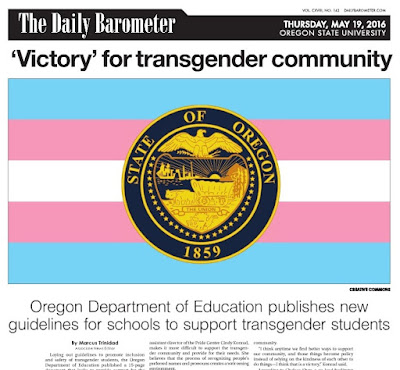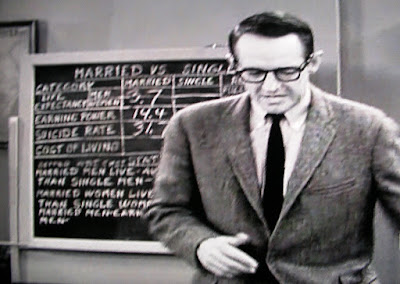PHOTO: The front page of the Oregon State University student newspaper featured a headline story by Marcus Trinidad, "'Victory for transgender community' Oregon Department of Education publishes new guidelines for schools to support transgender students," Barometer, May 19, 2016, p. 1, 3. The Oregon Department of Education published a 15-page document to allow students to use their preferred names on official documents such as transcripts and diplomas, while not requiring any form of verification of someone's gender or preferred name. Oregon State University currently provides an option for faculty and staff to use preferred names for work purposes, but a similar option is not yet available to students. (issuu.com)
Republican groups have been purposely raising the transgender bathroom issue as a strategy for political gain, which has led to a public discussion about transgender rights. (See OSU student newspaper coverage by Luuk Van Hoomissen, "Oregon State University has over 200 gender inclusive on campus with plans for even more," Barometer, posted Jan. 29, 2016 - it quotes Steve Clark, vice president for university relations and marketing, saying, "In 2008 there were less than 30 gender-inclusive restrooms on campus that we can identify by records. Today there are 200." and see previous post OSU 'gender inclusive' bathrooms hit front page of student newspaper (2/3/16))
A couple of days before the Barometer's May 19, 2016, front page story on transgender rights (shown above) was printed, an Oregon State University student editorial columnist also joined in to comment on the bathroom discussion: Sean Bassinger, "Transgender, gender non-conforming rights: It's about more than 'just' bathrooms," OSU Barometer posted May 17, 2016. Bassinger noted, "On May 6, The Daily Barometer published an article titled "Making restrooms a safe space," which focused around buttons that read "#IllGoWithYou" in support of transgender safety and rights on college campuses." (Note: I can't find the May 6 story he references, but see previous post OSU 'gender inclusive' bathrooms hit front page of student newspaper (2/3/16))
All of the above newspaper pieces, in addition to the wider public discussion on transgender rights, prompted me to write the following letter to the editor:
The recent public debate, concerning which restrooms transgender people should use, focuses on so-called "biological sex" instead of acknowledging how a similar debate, fifty years ago, was misused to justify discrimination against both lesbians and gay men, based on how restrooms and locker rooms were used by gay men who are cisgender (i.e. their male gender identity matches their male biological sex).
Historically, a few closeted gay men loitered in men's "tearooms" while "cruising" to hookup, or occasionally to "service" a heterosexual man, which led to laws prohibiting this type of "lewd" public sex behavior.
It wasn't until I was old enough to be involuntarily drafted into the military, when I first learned why my parents never allowed me to go unaccompanied to the Greyhound bus station bathroom or the YMCA gym in the city where I grew up.
I have no problem with transgender individuals using the restroom of either sex, provided they follow the same social customs and laws against lewd behavior that gay men have been successfully obeying for decades.
My Swedish Grandmother used to scoff at the prudishness of Americans by bragging how in the 19th Century she saw entire families naked in Sweden's public baths.
Thomas Kraemer
Founder, OSU Foundation Magnus Hirschfeld Fund for research concerning humans or animals with a minority sexual orientation or gender identity
I intentionally toned down the sexual language in my letter, to avoid causing any discomfort to some students, in order to better make my basic point that instead of prohibiting transgender people from using the restroom of their choice, the public discussion should be on how to fairly and equitably prohibit any bad behaviors, such as "lewd and lascivious behavior" by a purported "male" in a women's restroom. I believe most females are in fear of being attacked by a male in a deserted restroom, but in my experience, their deeper and unspoken fear is having a male stranger looking at them lecherously while they are undressed. I believe that very few people like peeping toms and this is why laws against voyeurism exist. Similarly, very few people want to be exposed to any unwelcomed sexual advances or activity, which is why laws have been passed against lewd behavior. Although these laws, by themselves are fine and easy to support by most people, there is a shameful history of these laws being unequally enforced to discriminate against marginalized groups, such as gay men. Of course, this issue has always been dependent on the context of our times and culture, just as my Grandmother taught me, because nudity is more or less threatening to different people, at different times, and in different cultures.
For example, I vividly recall my fear of entering the 7th grade because this was when my school first required all boys to undress in a locker room, put on a jockstrap and gym clothes before gym class, and then shower naked afterward in a gang shower full of boys. Adding to my fear, the swimming lessons were held in a pool while stark naked, in each boy's birthday suit, in order to avoid having to dry any swimsuits. The reasons for my fears were validated the very first day when I witnessed one boy get an erection and then the other boys viciously beat him up for it while calling the boy a queer (in fact, this boy was not gay, but like many adolescent boys he was prone to getting spontaneous erections.) Worse yet, instead of defusing the situation, the adult male gym coach looked the other way and retreated to his office that had a window, where I hope he was at least watching to see if the violence got out of hand. It was only years later that was I able to talk to other men, both straight and gay, about their fears of getting an erection in the locker room. Nobody wanted to talk about it.
Similarly, I had my first experience of both fear and disgust when I received an unwelcomed sexual advance from a lecherous old man (the older man was as probably 60 years older than me) when I was 14 years old and I was just aimlessly wondering around the streets of a big city by myself for the first time. This experience made me wonder why some boys, who were the same age as me, said they were very attracted to the same old men that disgusted me -- these boys told me they liked the more mature masculinity of these older men much better than their twink adolescent peers.
I was never comfortable with talking to anybody about my fears and disgusts, because I assumed other people would make fun of me. It was only much later in life when I realized how my silence, due to being intimidated by others, actually enabled bad peoples' ability to manipulate others and coerce them into doing sexual things, which they might regret afterward.
See previous posts:
- OSU 'gender inclusive' bathrooms hit front page of student newspaper (2/3/16)
- OSU Pride Center moves to be 'Brave Space' and 'gender inclusive' instead of 'Safe Space' or 'gender neutral' (12/2/15)
- Book: 1912 Portland 'Vice Clique' gay sex scandal, OSU football player, and possible Women's Suffragists linkage (3/22/14) - an OSU football player was arrested for having gay sex in early 20th Century Portland, Oregon
- OSU library tearooms mentioned in letter about sex video (2/4/15) (Note: tearoom is slang for T-room or toilet room, which picks up on the idea that most toilets are made of porcelain china, like a teacup.) - letter writer Kim Wilson says, "On the other hand, I bet some of today's students, both male and female, feel just as violated as I did nearly half a century ago when a male flasher targeted me in the old OSU library."
- Senator Craig promotes public sex (8/29/07) - Idaho Republican U.S. Senator Larry Craig represents the "old closeted gay culture" that regularly used unhealthy public sex venues for anonymity. While at the same time Sen. Craig was leading anti-gay votes for anti-gay legislation in Congress, he was hypocritically having his dick "serviced" (ie. being blown, sucked off, having oral sex) in restroom tearooms by those "queers" he wanted to legally discriminate against. Sen. Craig, who is supported by LDS Mormons, is just one example of many self-hating closet cases who hypocritically bash gay men while secretly engaging in gay homosexual acts themselves.
- Magnus Hirschfeld book notes 24 to 26 - (p. 536) Tearooms (public bathrooms used to solicit gay sex) were documented and discussed nearly a Century ago by German Scientist magnus Hirschfeld. He notes how the most popular tearooms are out-of-the-way and rarely used by the general public. The walls are often covered with graffiti and crude drawings of phalluses. He found these images around the world.
- OSU Craig's List back to school ethnography (10/5/10) - The ground breaking ethnography of gay tearoom public sex was written by Laud Humphreys, "Tearoom Trade: Impersonal Sex in Public Places," 1970. The best tearoom sex locations were traditionally out-of-the-way, low traffic, locations that allowed gay men to be undisturbed by the "breeders." This is why top floors of libraries and basement restrooms were often popular. The infamous OSU tearooms located in the Memorial Union basement bathroom (it was eliminated in a recent remodel) and the tearoom on the 6th floor of the library (it was remodeled for the Valley Library addition) were documented in the gay guide book by John Francis Hunter (the pseudonym for John Paul Hudson) that is pictured in my previous post The Gay Insider USA 1972 (9/15/06).
- Gay public sex in Corvallis (2/6/07) -Gay public sex in Hyak Park was featured on the front page of the combined Albany and Corvallis Sunday newspaper in a story by Ian Rollins, "Despite Hyak Park's online reputation, the place is safe, officials say," Jan. 4, 2007, p. A1.
- 'CBS Reports: The Homosexuals' 1967 (2/14/10) - story of a 19-year-old soldier being arrested for the first time, for committing a lewd act in public. (NOTE: In fact, he did not actually commit a sex act in public, but made the mistake of asking an undercover police officer for oral sex in a public restroom often used by gay men "cruising for sex," also known as a "tearoom." Entrapment in these types of police sting operations was common back then.)
- Gay public sex in Salem (7/14/07) - Portland TV news runs a breathless story about a park in Salem, Oregon being closed due to gay public sex activity.
PHOTO: The OSU student newspaper print edition of my letter: Thomas Kraemer, "On Transgender Issues," Barometer, May 23, 2016, p. 7 posted online as "Letter to the editor: In regards to transgender issues," May 23, 2016 -- In the letter, I note how, fifty years ago, a similar bathroom debate was similarly used to justify discrimination against both lesbians and gay men. (issuu.com)







